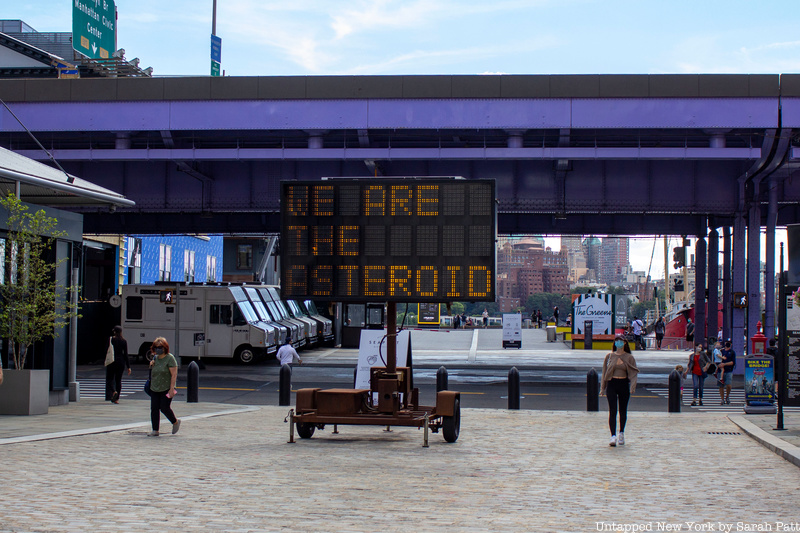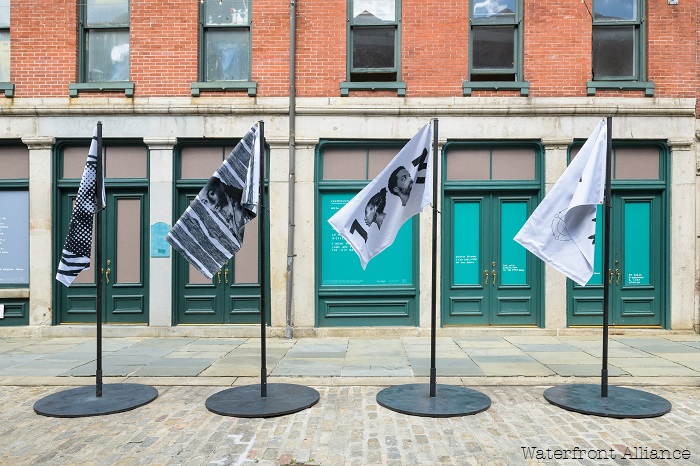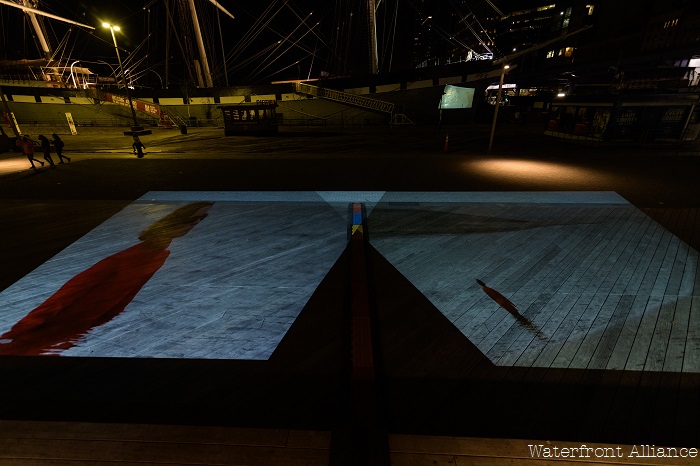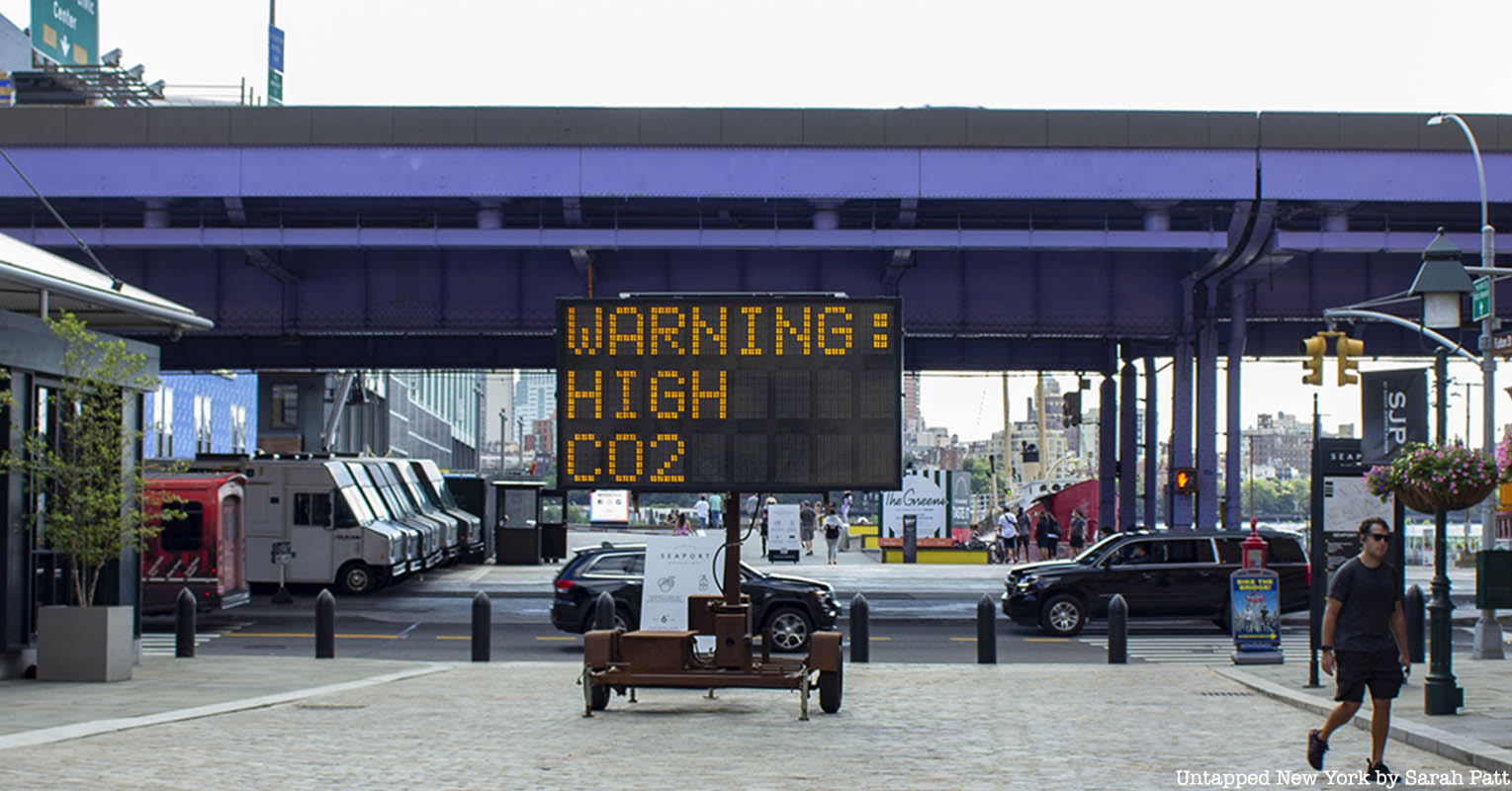Art at the BlueLine, an outdoor multimedia art exhibition, was exhibited during the 13th annual City of Water Day in the Seaport district on Saturday. Organized by the Waterfront Alliance and named after the demarcation line that sets the boundaries on how far high tides will reach inland in 80 years. Art at the BlueLine showcases a number of artworks from award-winning artists such as Justin Brice Guariglia, Kamau Ware and Sarah Cameron Sunde to highlight the threat of sea level rise and coastal flooding.
“This year finds us in a very different place—struggling against the tide of a global pandemic and once again acutely aware of the vulnerability of our region to the unpredictable and catastrophic,” said Cortney Worrall, President of the Waterfront Alliance, in a press statement. “We must prepare our region for climate change—to protect the homes and businesses, the physical and cultural infrastructure that makes our region unique and helps ensure the safety and well-being of our residents.”
 Justin Brice Guariglia’s solar-powered LED warnings flash on the streets
Justin Brice Guariglia’s solar-powered LED warnings flash on the streets
One of the artists at City of Water Day, Justin Brice Guariglia, utilized sandblasted solar-powered LED highway signs, typically used by construction workers, in his installation “We Are the Asteroid II.” The signs echo his messages on climate change to the passer-bys, and the messages were written by Timothy Morton, a professor at Rice University, who employs poetry, metaphors and humor to make viewers contemplate an ecological mindset about the environmental conversations. One that cycles through says, “Warning: High CO2.” Guariglia first showcased this concept two years ago in New York in an installation entitled Climate Signals, with various LED highways signs placed all over the five boroughs — one of our favorites said “No Icebergs Ahead.”
Another artist, Kamau Ware, a visual storyteller, aligned himself with the ongoing racial social justice movement in the country in the work “Waves.” Four flags symbolically connect New York’s Indigenous people to Africans from 17th-century Congo and Angola who also lived on the island of Manhattan. This imagery illustrates his messages of resilience and highlights the more severe consequences of the pandemic on Black and Indigenous people.
 “Waves” explore how people of color have been erased from the local history. Photo by Ian Douglas.
“Waves” explore how people of color have been erased from the local history. Photo by Ian Douglas.
At the southernmost Manhattan waterfront of the East River is “36.5 / A Durational Performance with the Sea,” a large-scale video installation that features nine works created in places like the Netherlands and Bangladesh where climate change is becoming a larger problem. Started in 2013 by Sarah Cameron Sunde, the videos will be screened on outdoor walls and the Tall Ship Wavertree at South Street Seaport Museum on four nights (September 12, 17, 25 and 26) from 7 PM to 10:30 PM. Viewers have access to a typewriter to type responses to climate change questions in an environment that simulates the feeling of standing in the water, which Ms. Sunde did for 12 hours and 48 minutes in the aftermath of Hurricane Sandy.
 “36.5 / A Durational Performance with the Sea” started out as a poetic response to Hurricane Sandy. Photo by Ian Douglas.
“36.5 / A Durational Performance with the Sea” started out as a poetic response to Hurricane Sandy. Photo by Ian Douglas.
Art at the BlueLine is a free and socially distanced event that runs until September 27 for Climate Week NYC. Next, check out our behind-the-scenes look at the Wavertree ship, a cargo ship built in 1885 and has a historical connection to New York City.
Join us for our next tour of Lower Manhattan looking at the Remnants of Dutch New Amsterdam. All of our in-person tours have small groups, state-of-the-art radio ear pieces for safe social distancing, and more health & safety measures.






